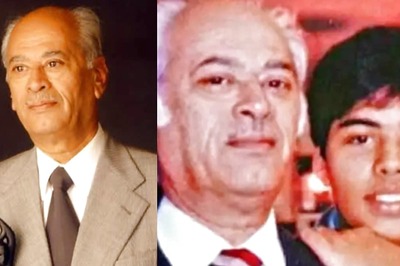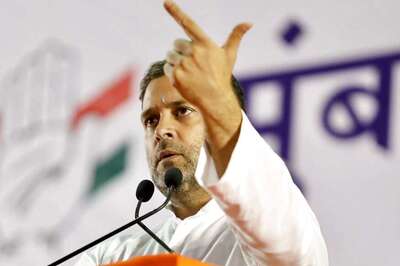
views
When the debt fund storm hit the mutual fund industry, it took the combined efforts of RBI and SEBI to save it. But now that calm has returned with the help of cash infusion and tighter rules for investors, some fund managers are underplaying the enormity of recent events. It was a passing liquidity problem that has been solved, they argue. But, is that all?
There are other mutual fund veterans who say the crisis brought to light more fundamental shortcomings that mutual funds had gathered over time. As the Indian economy brimmed with cash surpluses in the past four years and fund managers competed with each other to garner more investible funds, discipline, transparency and governance fell as victims. If another crisis is to be avoided, funds should introspect and go back to basics, they say.
India’s oldest mutual fund, UTI, is perhaps taking the lead in questioning the industry’s practices, especially in selling and managing FMPs. “There was no transparency. Misselling used to happen. How healthy was the system we were building? Was there a compromise on quality?” asks U.K. Sinha, UTI’s chairman and managing director.
Already, some solutions have started coming in. In the first week of December, a few days after AMFI circulated its set of recommendations to streamline the FMP system, SEBI mandated that all close-ended schemes, including FMPs, be listed on the stock exchanges. It also prohibited premature redemptions on such funds, making the exchanges the only route for early exit.
The regulator’s moves have addressed one facet of the problem, namely a liquidity crunch that could result from a run on a close-ended fund. After all, the recent crisis was marked by such large-scale early withdrawals. Henceforth, an investor would have to go and sell the units in the stock exchanges only.
While SEBI has advanced a limited solution for the cash flow worries of funds, it is yet to address the larger problems that investors are worried about. Also, close-ended funds suffer low liquidity on the exchanges and finding a buyer for an FMP will be very difficult. Even if a buyer is found, the market price could be lower than the net asset value, forcing a discount on the seller. These lacunae could drive away investors from such schemes. Perhaps for this reason, even AMFI’s discussion paper had recommended only increasing the exit charge rather than a complete ban. “It is going to be tough for anyone to come up with FMPs in the current situation,” says D D Rathi, whole-time director and CFO (Chief Financial Officer), Grasim Industries.
SEBI chairman C.B. Bhave himself maintains that these are only the first set of measures to deal with what was immediately possible and necessary. More decisions would be taken in due course to streamline the debt fund market, he said.
He has a handful of issues to look into.
A matter of discipline
FMP managers have often invested in debt papers with a term longer than the scheme itself, to earn higher returns. This meant that the amounts would be still locked in when a scheme closes and investors ask for money. The fund house would pay the investors with money from its cash flow outside the scheme. This was a dangerous ploy, betraying a lack of prudence. “As far as mutual fund and their crisis in India is concerned, it is due to bad product creation. Any product that allows non transparency is a bad design,” says Nachiket Mor, head of ICICI Foundation. SEBI has now made it mandatory for schemes to invest in paper that matches with the tenure, hopefully ending the vicious spiral.
But there are other practices that have come under scrutiny.
The first thing being questioned is the funds’ practice of giving indicative returns. The debate is whether it is a market sin: guaranteeing returns. Since the maturity period of an FMP is fixed, given its close-ended nature, funds got into the habit of giving indicative returns to attract investors. Several fund houses would launch their FMPs on the same day and each would need to make some unique proposition to win attention. A higher interest return, indicative of course, was a sure bet.
The mutual fund industry, however, defends the practice of indicative returns. “The investor comes with a locked in maturity. Till now, there is not an AMC which has not delivered indicative returns,” asserts Nilesh Shah, deputy managing director and chief investment officer at ICICI Prudential Mutual Fund.
But what did it entail? Mutual funds had to stretch their investment strategy to include paper that would yield higher returns. The risk profile, too, would then get enhanced. But in times of abundant cash, risk is relegated to a theoretical study and the investors keep signing in.
Another vortex that fund houses can get sucked into is the extra commission that they pay to distributors. Given the very low fee structure in India, and the ceiling imposed by the regulator on the commissions, fund houses shouldn’t be overpaying the distributors at all. As Ashu Suyash, CEO (Chief Executive Officer) of Fidelity Mutual Fund, points out, high commissions create an imbalance in the market and distributors favour those paying higher.
But the reality of competition and the inability of mutual funds to expand their own network beyond a point, force them to depend on distributors to push a scheme into the market.
Third-party distributors are a powerful lot in deciding the future of a scheme. This has led to the nearly three dozen AMCs competing with each other in pampering distributors. AMCs pay commission out of their pockets over and above what they can pay from the official expense ratio. This cuts down their profitability. This is where the need for regulating distributors has arisen.
Capital adequacy is one of the safeguards against liquidity problems. As things stand, the networth requirement of AMCs is a mere Rs. 10 crore, even if the assets exceed tens of thousands of crores. “SEBI should, as it is presently considering, prescribe prudent networth requirements that would enable AMCs to meet liabilities,” says Cyril Shroff, managing partner at Amarchand & Mangaldas & Suresh A. Shroff & Co.
A matter of transparency
At the time of launch, an FMP typically gives an indicative portfolio to give investors an idea of where their money would go. But in some cases, the actual portfolios were found to be different from the indicative portfolios.
The opinion increasingly within the industry is that fund managers should resist floating model portfolios and just stick to a broader outline. “Though it is possible to give a model portfolio in a fixed income product, it need not be indicated in full. It is enough if the fund says where it is mandated to invest – broad categories like bank FDs, debt of manufacturing companies,” says T.P. Raman, CEO, Sundaram BNP Paribas Mutual Fund.
But more serious are the instances when FMPs had strayed from their declared mandate and invested in more risky debt or a different mix of paper. This considerably changed the risk profile that the investor had not committed to. So, the first solution being proposed in the sector is for SEBI to ensure that FMPs follow their mandate strictly.
With six months to declare the portfolio, debt funds have a lot of time to play around with the mix of investments. So, the frequency could be reduced to just one month, which will bring in more transparency. Another idea is to require a disclosure as and when a significant change is made in the portfolio.
It is the lack of information that breeds panic. Investors will assume the worst when they don’t know the facts. A distributor who has been selling mutual fund products for over a decade said he had never perceived FMPs to be risky. But when reports about FMP problems appeared in the media, he wanted to ensure the schemes in which his clients had invested remained safe investments. Also, “I have told my clients to keep away from FMPs temporarily”.
A matter of governance
“Did all the growth happen in debt schemes due to the superior fund management capabilities? It was because of the tax incentives corporate treasuries got,” UTI’s Sinha asks. Companies and high-networth individuals flocked to FMPs because the tax burden is lower than that on the returns on fixed deposits. Sinha calls for abolition of this tax benefit, so that the funds would sell FMPs and investors would put in money for what they’re.
Misselling took different forms. “I am aware of cases where people are sold instruments that are not relevant to them,” says a distributor. In one instance, a trust was lured to invest its entire corpus of Rs. 1.5 crore in a single scheme, a concentrated bet that the trust may not be able to sustain.
No amount of regulatory oversight can bring in order to mutual fund industry as self-regulation can. A few months ago, SEBI began a discussion on the role of trustees in AMCs. Now, mutual fund trustees play a role similar to independent directors on company boards.
In a three-tier mutual fund business structure, trustees are supposed to play the role of safeguarding investor interest. “They have the powers to demand information from the fund management at all levels -- asset allocation, risk management practices, trading information,” says Susan Thomas, assistant professor, Indira Gandhi Institute of Development Research.
Those in the industry defend the current functioning of the trustee system, but it is unclear whether questions were raised when the FMP spree was on. Given the levels of disclosure in the MF industry today, I would not think that there is much to do by way of improving the powers of the trustees,” says Thomas.
But, more than ever, the mutual fund industry faces an urgent need to spruce up the trustees system to encourage whistle-blowers and usher in a self-balancing mechanism. One of the ideas SEBI is toying with is whether a professional, independent body of trustees could be set up. This organisation would do the external auditing of the way funds are run.
Opinion is divided on whether an independent body can be effective. “You cannot fix responsibility. It is your fund, your product innovation and it is only those who are looking at it specifically can be (made) responsible,” says Shailesh Haribhakti, managing partner and CEO of Haribhakti Group. Some cite overseas experience to dismiss the idea of independent trustee firms. “I am not in favour of that. I run a few international funds and I know that these companies do not look (at) anything but collecting their fees,” says Sinha.
Part of the problem in the mutual fund industry may be that there are too many players. It took India 15 years to get 35 mutual funds, but this year alone, 20 more queued up to set up shop. Given the limited profits, there may not be room for all. “It is not a greatly profitable industry. Intermediaries make more money,” said the CEO of a new AMC. Naturally, mergers and acquisitions are inevitable.
Sinha says only players with the ability to withstand losses for 3-5 years and have the infrastructure to tap retail money on a regular basis can survive in this market.
As the industry comes to grips with the crisis, it also faces lasting changes in regulation and adverse market conditions. The loopholes can be fixed, but to regain investor confidence, mutual funds have no recourse but better discipline and good performance across markets.
Like this article? Download it




















Comments
0 comment